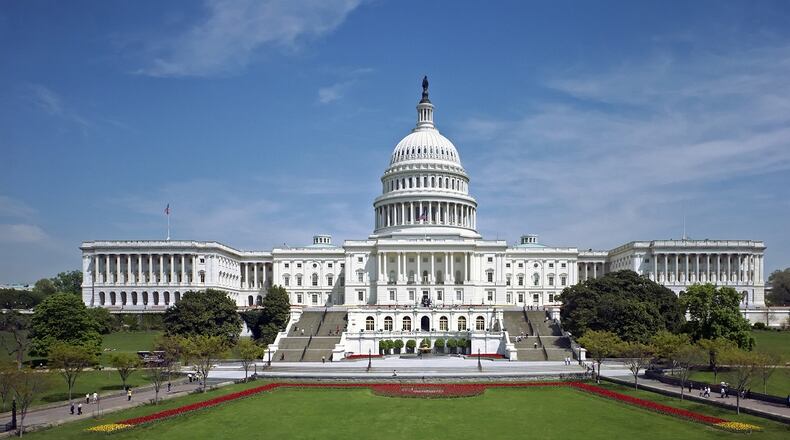Related: Ohio may change the way congressional lines are drawn
State Sen. Matt Huffman, R-Lima, and Ohio House Speaker ProTempore Kirk Schuring, R-Canton, said the updates to Senate Joint Resolution 5 would increase the role the minority party plays in determining how Congressional district lines are drawn every ten years.
“By defining a process and ensuring bipartisan support, we are proposing a historic change in how Ohio draws its congressional districts lines,” said Huffman, who sponsored SJR 5 and is part of a four-person bipartisan working group looking at redistricting reforms.
The two Democrats in the working group, State Rep. Jack Cera, D-Bellaire, and state Sen. Vernon Sykes, D-Akron, were not part of Huffman’s original proposal and on Monday said that the latest modifications are “cosmetic changes to a plan that writes gerrymandering into our state constitution.”
“After lengthy discussions and significant public input, it is clear Republicans will not take the necessary steps to end partisan gerrymandering once and for all,” Cera and Sykes said in a joint news release. “By rejecting suggestions to keep communities together and require bipartisan support for new districts, Republicans are rejecting the bare minimum standards needed for real reform and diluting the power of voters. Ultimately, we feel we have the responsibility to listen to the Ohioans who have spoken out and demanded real reform.”
Gerrymandering is the process of drawing congressional and legislative district lines to favor a certain party or candidate. Federal law does not currently outlaw partisan gerrymandering but the U.S. Supreme Court is considering two cases that could overturn the practice that has been used over the years by both Republicans and Democrats to gain partisan advantage.
Huffman hopes to get his proposed constitutional amendment on the May 8 ballot but has said he will not go forward with it unless he has Democratic support in both the Ohio House and Senate.
RELATED: Debate over how Ohio should draw congressional districts heats up
Fair Districts = Fair Elections, a coalition of good government groups led by the League of Women Voters of Ohio and Common Cause Ohio, is collecting voter signatures to put its own reform proposal on the November ballot.
The coalition contends the state was gerrymandered to favor Republicans when the GOP-dominated legislature redrew the lines in 2011. Even though Ohio is about evenly balanced politically, Republicans hold 12 of the state’s 16 congressional seats and since the 2012 election no seat has changed hands from one party to the other.
“We gave it our best but we were always very clear about what our line in the sand was,” said Heather Taylor-Miesle, executive director of The Ohio Environmental Council and one of the coalition members negotiating with Republicans for a week.
“Any deal needed to end partisan gerrymandering, have a bipartisan process and keep communities together. This doesn’t do it and this is why people don’t trust politicians,” Taylor-Miesle said.
In 2015 Ohio voters decisively approved a constitutional amendment reforming how the state’s legislative districts are drawn.
RELATED: Issue 1 would change how legislative district lines are drawn
But after it passed Republican legislative leaders resisted calls to remove the state legislature’s direct control over congressional district boundaries. Huffman’s proposal retains the legislature’s power to draw the lines but it does allow a redistricting commission to draw a four year map if the legislature can’t produce a 10-year map with the required level of bipartisan support. The state legislature could then turn the four-year map into a 10-year one if one-third of the minority party members voted to do so. Huffman’s earlier proposal required a vote of one-fifth of minority party members to do so.
RELATED: Ohio could have two redistricting proposals on ballots this year
The modified proposal released on Monday also reduces the number of times the state’s counties can be split, restores the governor’s power to veto the map, and allows citizens to file a referendum against the map.
The Fair Districts’ competing proposal mostly mirrors the 2015 constitutional amendment. It would put congressional redistricting in the hands of the Ohio Redistricting Commission consisting of the governor, secretary of state, state auditor and one person each appointed by the Ohio House and Senate majority and minority parties.
Map approval would need a majority vote, with at least two members of the minority party agreeing.
The proposal would outlaw gerrymandering, minimize the splitting of counties and communities, require that districts be compact and nearly equal in population, mandate transparency in the process and require representational fairness using a ten-year tally of Ohio voters’ partisan preferences.
RELATED: Reformers target political districts
Huffman has said that the Fair Districts proposal is the one that would enshrine in the constitution the practice of partisan gerrymandering because it includes the representational fairness requirement.
Fair Districts officials scoff at that, noting that their proposal’s representational fairness provision was also part of the 2015 constitutional amendment that Huffman toured the state promoting along with Sykes after the legislature put the issue on the ballot.
“Voters deserve fair districts that aren’t manipulated,” said Catherine Turcer, executive dirctor of Common Cause Ohio. “The Huffman proposal was amended but allows drawing district lines for partisan advantage and allows communities and counties to be sliced and diced. It would simply legitimize gerrymandering in the Ohio Constitution. We’re going to fight it.”
Other stories by Lynn Hulsey
Local welder to be first lady’s guest at State of the Union
U.S. Senate: Gibbons gets endorsement from head of Montgomery Co. GOP
Crowded governor field puts Democratic race up for grabs


